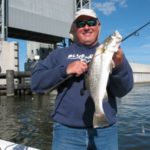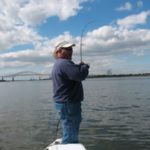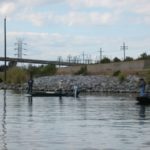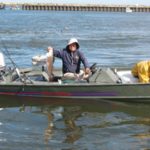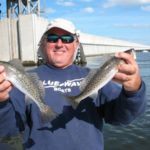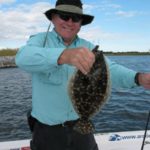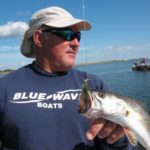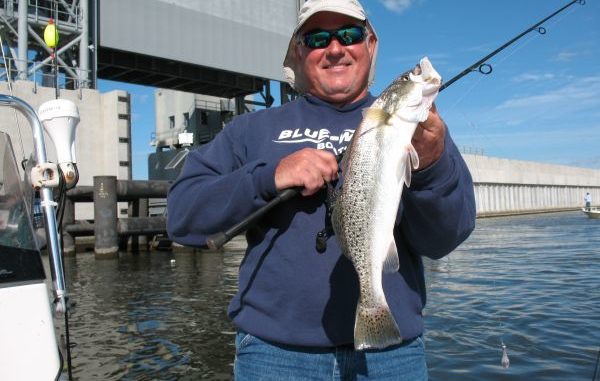
The fishing is so good at this new Southeast Louisiana landmark that you’ll wonder why you’re not fishing it. Here’s how to mop up.
There are some very famous walls in our world. For instance, there’s the Great Wall of China, a historical monument and one of the rare, still-extant wonders of the ancient world. It stretches out over a distance of 5,000 miles and took two millenniums to build.
Or consider the Wailing Wall in Jerusalem. It’s a 187-foot-high section of the ancient wall of Herod’s Temple, the very temple where Jesus Christ overturned the tables of the money-changers and drove them out of its sacred precincts.
The Wailing Wall is considered one of the most-sacred spots on earth, and the site is revered by Jews, Christians and Muslims.
There’s also the Vietnam Veterans Memorial Wall in Washington, DC, that is inscribed with the names of over 58,000 service men and women either killed in or still missing as a result of the Vietnam conflict.
Like I said, there are some very famous walls.
But there is yet another wall of some fame that is gaining in local popularity (although it pales in comparison to the previously mentioned walls).
Here in Southeast Louisiana, we do have our own Great Wall. It’s not religious in nature, as is the Wailing Wall. It’s not a sacred memorial, as is the Vietnam Veterans Wall. Nor does it keep out marauding hordes of barbarians at bay, as did the Great Wall in China.
But the Great Wall of Chalmette does serve a great purpose, and is quite an engineering feat in its own right.
Our wall towers about 25 feet above the waterline and is almost two miles in length. It traverses the “Golden Triangle Marsh,” stretching across the MRGO, the Gulf Intracoastal Waterway and Bayou Bienvenue from the Michoud floodwall north of the ICWW to the levee on the west side of the MRGO.
It also is the largest such project in the history of the U.S. Army Corps of Engineer. It includes a 150-foot-wide gate on the ICWW and a 56-foot-wide gate at Bayou Bienvenue, both of which can be closed should a hurricane threaten the area.
No gate was constructed on the MRGO, so it’s now walled off in Chalmette and Hopedale.
The price tag for the Great Wall of Chalmette: more than $1.1 billion and counting.
While locals simply refer to it as the Chalmette Wall, I’ve come to wonder why we don’t refer to it as the Wonder Wall. As in, I wonder why they didn’t build it before hurricane Katrina. Or I wonder why the Corps ever dug the MRGO to begin with. Or I wonder how it will perform under actual major hurricane conditions.
Or, better yet, I wonder why you’re not fishing there this winter.
I made a trip to the Wonder Wall recently with Capt. Mike Gallo (985-781-7811), and I brought along long-time friend Bob Mercer.
Gallo operates out of a camp on Salt Bayou in the Rigolets, so that meant we’d be covering some distance by water, and the forecast was for a very chilly morning with a rapid afternoon warm-up. We delayed our departure due to the cold, bundled up for the ride and headed down the bayou at the break of 9 a.m.
The ride would take us across a section of Lake Pontchartrain into Chef Pass, and from there into the ICWW toward Chalmette and the Wall.
Gallo said the Wall gets most of the publicity, but the entire area around the structure is producing fish right now — and that action should continue well into April.
“This area has become a wintertime trout and redfish destination,” he said. “It has everything that fish seek out when it gets cold.
“The deep water of the MRGO and the ICWW, the Wall, the Hot Water Canal and all the surrounding marsh combine to make this whole area hot when it’s cold.”
From the ICWW, Gallo turned into Cut Off Bayou, and from there we made our way to Bayou Bienvenue at the Wall. A large lift gate towers over the Wall at Bayou Bienvenue, so it’s visible from quite a distance.
A strong current was flowing through the 56-foot-wide gate, and boats were anchored all along the outflow and even along the Wall canal.
Gallo slowed the boat to a crawl so as not to disturb the other anglers, and he chose a spot near the gate to drop anchor.
“You can see how hard the current is flowing through the gate, and that current is dragging shrimp and baitfish along with it,” he explained. “You want to position your boat so you can throw your bait into the current lines from the outflow.”
But don’t show up with a wimpy anchoring system.
“Bring a good anchor and a lot of chain, because its deep right here and you don’t want your boat breaking loose in the strong current and crashing into another boat,” Gallo said.
Many others obviously know it’s a good place to catch fish because the boats were parked all around it — and we could see several reeling in fish.
Gallo uses a 13-pound anchor here and some of the heaviest chain I’ve ever seen used on a bay boat.
“It’s a beast,” he said of the anchor and chain, “but it holds.”
And it did.
We started fishing immediately, throwing into the swirling current and allowing it to sweep our bait downcurrent.
“When your sinker hits the bottom, reel in the slack and work it back toward you in small, short hops,” Gallo instructed.
He was using a white, curly tail plastic on a drop-shot rig. A 1-ounce bank sinker hung about 8 inches above a 1/8- or 1/16-ounce jighead.
The heavy lead ensured the rig would sink to the bottom. He used 30-pound braided line to get the maximum feel, because the bite is so soft in the winter.
“Sometimes you feel only a very slight tap or quiver in the rod tip, and sometimes you feel nothing except a little resistance when you make your short hops,” Gallo said. “If you feel anything, set the hook — especially when fishing with plastic.
“Fish don’t have hands to grab or feel with. They do everything with their mouth, and their mouth is so sensitive to taste and texture they’ll spit your plastic in a heartbeat, so you have to be quick to set the hook or they’re gone.”
Gallo had Mercer baited up with the same rig, while I tightlined a plastic cocohoe on a 3/8-ounce jighead.
Gallo caught a decent trout, followed by another. And Bob caught one and missed one. I was yet to get a bite.
“Let me know when you want to switch to a drop-shot rig,” Gallo taunted, as he reeled in yet another trout.
Five barren minutes later, I switched to an identical drop-shot rig and started catching fish.
I might be a slow learner, but I do learn.
There are several options in the area, and each can result in boxes of fish.
“You can fish either side of the Wall, and you can fish it anywhere along the length of it,” Gallo said. “Most people like to fish near the outflows at the gates, either on the ICWW or at Bayou Bienvenue. There are some nooks and crannies to hide and fish around the gates of the ICWW, and you can catch fish there.
“The key is to look for cleaner water and fish the side with the current falling out.
But concentrating on the direct outflow isn’t the only choice.
“You don’t have to fish directly in the current to catch fish, because often the trout will hang just outside of the current and wait there to ambush bait,” Gallo said.
He said the stronger the current the farther back you can expect to find fish.
“Strong current forces the fish to swim hard just to stay in one spot, so they’ll hang back and pounce on bait as it’s swept along,” he said.
But you can also move away from structure and find plenty of action on the ICWW.
“It’s about six miles from Chef Pass to the MRGO, and I see boats anchored all along the way,” Gallo said. “Personally, I like to troll very slowly and cast the same bait out toward the center of the ICWW and make slow short hops with the bait as I reel it back toward me.
“The fish usually hang along the drop-offs, so if you troll or anchor in the shallows along the bank you can cast into the deep (water) and work your bait back in.”
He does make a change in his equipment when he moves away from the Wall, though.
“I recommend downsizing your plastic, using smaller baits either on a drop-shot rig or a tandem rig,” Gallo said. “I like to use a heavier, ½-ounce jig on the bottom and a lighter jig on the top — either a ¼- or a 1/8-(ounce), depending on the current.
“I also like to experiment with my plastics and colors. I might try a small Gulp! bait on the top jig and a curly tail on bottom or vice versa, and I pay attention to what gets the most strikes. When one color or bait gets all the action, I use it on both jigs.”
Gallo said he fishes the MRGO exactly the same way as the ICWW. He likes to slowly troll along the edges while casting into the deeper water and then use short, slow hops to work the bait back to the boat.
“If I find a spot where we get some good bites, I’ll put the anchor out and see if we can put some numbers in the boat,” he said. “Another thing I look for, especially when fishing the MRGO, is shrubs and trees along the bank. If I see that, I’m going to fish that area because it indicates a harder bottom.
“Fish just seem to prefer hunting over harder bottoms, whether because bait can’t escape them by burying themselves in the soft mud or — as some theorize — harder bottoms, especially shell bottoms, retain heat longer.”
Another take on fishing the MRGO is that suggested by David Dixon at Bait Inc.
“I trawl up and down the MRGO for our bait shrimp, and I regularly see boats drifting the middle or just off the middle, casting out and fishing the bottom in 25 to 30 feet of water, and catching some very nice trout,” Dixon said. “It makes sense: The shrimp are down there, so why wouldn’t the trout be down there, too — especially in this colder weather.”
Dixon said he regularly sees anglers employing that technique from the Violet Locks south toward Shell Beach, all along the channel.
Another long-time winter hotspot is the Michoud Substation Hot Water Discharge Canal that serves as a discharge for the heated water cooling the massive equipment in the adjacent energy plant.
The fact is that the warm water in the canal attracts fish when water temperatures elsewhere plunge.
The narrow canal can get pretty crowded, especially on weekends, so if you choose to venture in you need to be courteous and prepared to lose some tackle — especially around the mouth of the canal.
Gallo doesn’t fish the locks at Bayou Bienvenue and the Violet Canal because of the constant traffic and irritation, but he said they can be very productive.
“Look at it this way: If they didn’t produce fish, you wouldn’t always see boats anchored all around them,” he said. “I don’t generally see people loading the boat there, but they usually catch enough to keep them trying and to bring them back.
“You’ll catch drum, sheepshead, trout, reds — a bit of everything there, if you fish live or market bait. And the best way to fish it is with a sliding-cork rig to keep from losing all your tackle in the debris on the bottom.”
At our spot at the opening to the Wall, and it must have died everywhere else as well because boats started moving restlessly around like 6-year-old kids on a playground. So many boats drove past us we thought it was a parade.
When you see that many boats running around, you know they aren’t catching fish and they’re hunting for a better spot.
Gallo employed his 10-minute rule: That is, if we don’t catch a fish in 10 minutes, we move.
So, we moved, just like everybody else.
Gallo went to the ICWW and started trolling along the shallow bank in 3 to 5 feet of water, and we’d cast into the deeper water toward the middle. After just a few minutes we got some good strikes and Gallo dropped the anchor.
We put quite a few very nice trout in the boat at that spot until we pulled anchor for the journey home.
Here’s what I took away from that trip.
First, the Wall is quite an impressive structure, and is a worthwhile fishing destination in its own right.
Second, between the ICWW and the MRGO, this area does attract a variety of fish to its deeper, warmer water. Trout, reds, flounder, drum and sheepshead are all on the menu.
Third, it’s so close to New Orleans and the surrounding parishes, and so easily accessed by a very short boat ride that you just have to try it. Three launch sites on Paris Road make it one of the easiest trips you’ll make.
It’s no wonder, then, that I’ve already made a return trip, with more planned. Wonder if I’ll see you out there?
Editor’s note: Capt. Mike Gallo can be reached at 985-781-7811.
